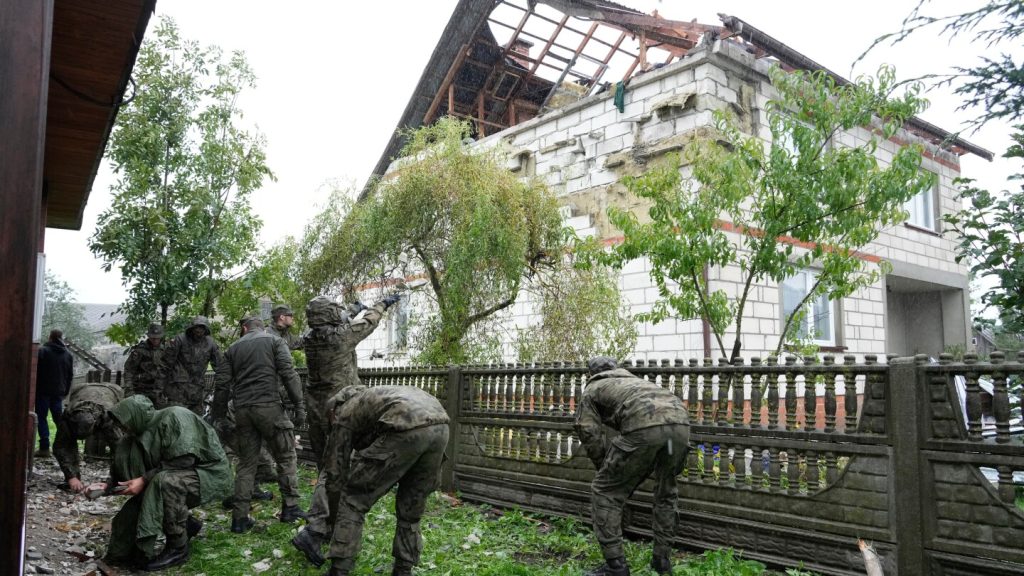Poland and Romania are deploying a new weapons system to defend against Russian drones, following a spate of incursions into NATO airspace in recent months that exposed the alliance’s vulnerabilities and put Europe on edge.
The American Merops system, which is small enough to fit in the back of a midsize pickup truck, can identify drones and close in on them, using artificial intelligence to navigate when satellite and electronic communications are jammed.
As well as being deployed in Poland and Romania, Merops will also be used by Denmark, NATO military officials told The Associated Press, part of a move to boost defenses on the alliance’s eastern flank.
The aim is to make the border with Russia so well-armed that Moscow’s forces will be deterred from ever contemplating crossing, from Norway in the north to Turkey in the south, the officials said.
The need for such technology became acute after around 20 Russian drones flew into Polish airspace in early September. Multimillion-dollar jets were scrambled to respond to drones which cost tens of thousands of dollars.
Romania later faced a drone incursion, while drones temporarily closed airports in Copenhagen, Munich, Berlin and Brussels. There were also sightings near military bases in Belgium and Denmark.
While the origin of the drones could not always be traced to Russia or linked to its war in Ukraine, the urgent need to bolster defenses is clear. A protracted drone battle — or full-scale war as in Ukraine — would drain Western coffers and limited stocks of missiles.
“What this system does is give us very accurate detection,” said Col. Mark McLellan, assistant chief of staff operations at NATO Allied Land Command. “It’s able to target the drones and take them down and at a low cost as well. … It’s a lot cheaper than flying an F-35 into the air to take them down with a missile.”
A bird, a plane, or a drone?
Drones fly low and slow, making them hard to pinpoint on radar systems calibrated for spotting high-speed missiles. They can also be mistaken for birds or planes. The Merops system, NATO officials said, helps plug those gaps.
Merops “basically flies drones against drones,” said McLellan, either by firing directly at the hostile drone or information from the system can be passed to ground or air forces so that they can shoot it down.
Merops gives commanders “a certain amount of time to be able to assess the threat and decide — to shoot or not shoot,” said Brig. Gen. Thomas Lowin, deputy chief of staff operations at NATO Allied Land Command.
It can be used to protect both critical infrastructure, such as airports, and armed forces maneuvering in a combat zone, he added.
NATO is now deploying the first systems along the borders of Poland and Romania, while Denmark has also decided to acquire the Merops technology, Lowin said.
Former Google CEO Eric Schmidt has invested in Merops, but both he and the company are keeping a low public profile, declining requests for interviews. Defense officials from Poland and Romania also refused to comment publicly.
The big picture
The Russian incursions have concentrated minds in Europe, highlighting the need for new defenses against a rapidly developing form of warfare. The Merops system is one of many that European militaries would need to tip the scales of a drone war in NATO’s favor.
European companies are now developing new technologies, including drone-against-drone systems like Merops and anti-drone missiles, while European Union countries have agreed to work together to create a “drone wall” on the bloc’s eastern border.
U.S. military leaders in Europe are also advocating for the creation of an Eastern Flank Deterrence Line, a layered zone of defenses along NATO’s border.
The commanding general for the U.S. Army in Europe and Africa — and head of NATO’s Allied Land Command — Gen. Chris Donahue said in July that he wants to create a network of sensors and a command-and-control system that will work with almost any hardware available — allowing systems to be swapped in and out as they are updated or become obsolete.
Russia has conscription and a large military, which means it has more forces immediately deployable than NATO along its borders. The alliance needs to build defenses which offset that manpower advantage by using its technological capabilities, Donahue said.
Merops is the first phase of building those defenses, said Lowin, a process which is forecast to take two to five years.
Zone of instability
The drone incursions and the instability on NATO’s eastern flank stem from Russia’s war in Ukraine, now approaching the end of its fourth year. The conflict has become a crucible for drone development, transforming the battlefield into a testing zone for new technology which now has applications elsewhere in Europe.
The Merops system has been chosen because it has been used successfully in Ukraine. If something doesn’t work there, it’s “probably not worthwhile acquiring,” Lowin said.
Drones are evolving rapidly, and each new type demands a different response: The challenge is to identify the threat and then almost immediately work out how to attack it, said Brig. Gen. Zacarias Hernandez, deputy chief of staff plans at NATO Allied Land Command.
That requires extremely fast production cycles — from development to battlefield within weeks.
Meanwhile, Russia is also mass-producing attack drones, equipping them with cameras, jet-propelled engines and advanced anti-jamming antennae.
It, too, has been forced to adapt, as Russian President Vladimir Putin acknowledged in early October.
Speaking about the military’s initial failures in Ukraine, Putin publicly admitted that “there were entire fields where our knowledge was simply non-existent” but claimed Russia was now able to field more advanced technology “within a matter of days.”
Ukraine, NATO and Russia are in a game of technological cat-and-mouse, the NATO officials suggested.
“We see what Russia is doing in Ukraine,” said Hernandez. “We have to be ready for that.”


